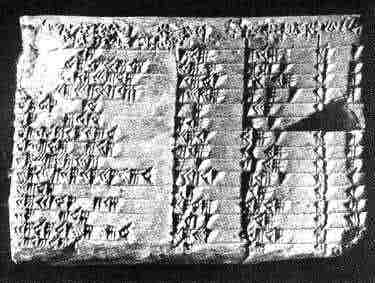

 One of the most interesting and more advanced mathematical tablets analysed has been called Plimpton 322. (It is now stored in the G.A. Plimpton collection at Columbia University under catalogue number 322). The tablet is dated at around 1900 to 1600 BC and was first described by Neugebaur and Sachs in 1945. Unfortunately a piece from the left hand edge has broken off.
One of the most interesting and more advanced mathematical tablets analysed has been called Plimpton 322. (It is now stored in the G.A. Plimpton collection at Columbia University under catalogue number 322). The tablet is dated at around 1900 to 1600 BC and was first described by Neugebaur and Sachs in 1945. Unfortunately a piece from the left hand edge has broken off.
Looking at the tablet in our own decimal notation, we can see that it contains three columns.
The extreme right column (see below) is simply numbering the lines. The next two columns, with four exceptions, are the hypotenuse and a leg of integral sided right-angled triangles. (The four exceptions are shown by putting the original readings in parentheses.) Three of the four exceptions, however, have simple explanations. In the ninth line, 481 and 541 appear as 8,1 and 9,1 in sexagesinal notation, so this error could just be a slip of the stylus. In line 13 we have the square of the correct value, and in line 15 we have exactly half the correct value.
|
A Pythagorean triple is a set of numbers like (3,4,5) which correspond to the (integral) side lengths of a right-angled triangle. If the set of numbers is relatively prime, we have a primitive Pythagporean triple. So for example, (3,4,5) is a primitive Pythagorean triple, but (9, 12, 15) is not.
Over a millennium after the time of the Babylonians, it was discovered that any Pythagorean triple can be written parametrically as |
|
It seems likely that the table on the tablet was constructed by choosing small regular numbers for u and v. Hence it appears that the Babylonians were familiar with the parametric representation of the Pythagorean triples! The fourth, and partially destroyed column of the tablet gives in fact the values of (c/a)2. These values are the squares of the secants of the angle B, opposite to the side labelled b. Moreover, these values of sec B form a sequence which progresses in almost exact increments of 1/60, corresponding to angles Back to Main Page |
|